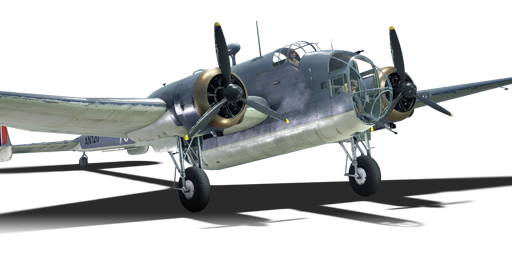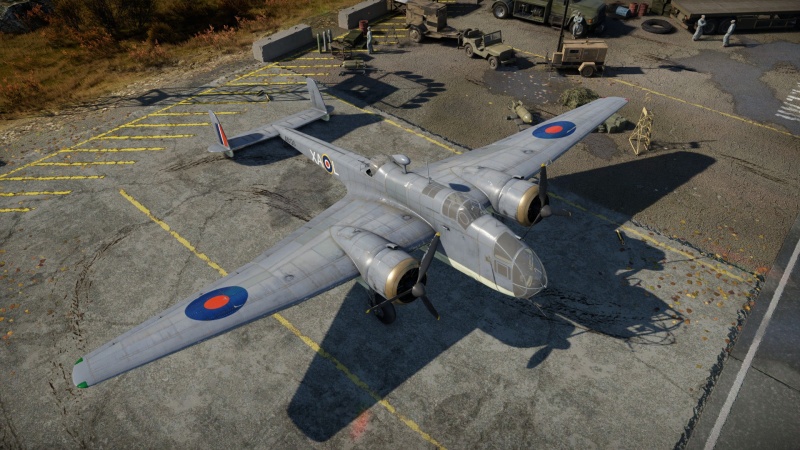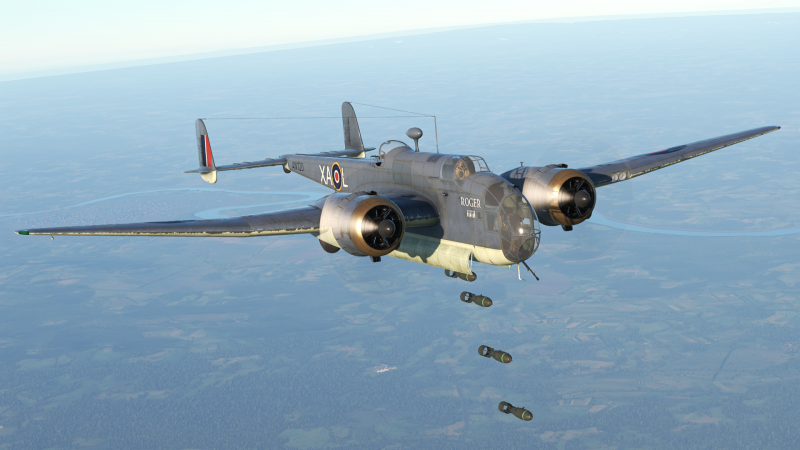Difference between revisions of "Hampden TB Mk I"
m (Specs-Card ArtImage Added) |
(→Suspended armament: Updated) |
||
| Line 100: | Line 100: | ||
{{Specs-Avia-Suspended}} | {{Specs-Avia-Suspended}} | ||
<!-- ''Describe the aircraft's suspended armament: additional cannons under the wings, bombs, rockets and torpedoes. This section is especially important for bombers and attackers. If there is no suspended weaponry remove this subsection.'' --> | <!-- ''Describe the aircraft's suspended armament: additional cannons under the wings, bombs, rockets and torpedoes. This section is especially important for bombers and attackers. If there is no suspended weaponry remove this subsection.'' --> | ||
| − | {{main|G.P. Mk.IV (250 lb)|G.P. Mk.IV (500 lb)|G.P. Mk.I (1,000 lb)|18 inch Mark XII (450 mm)}} | + | {{main|G.P. Mk.IV (250 lb)|G.P. Mk.IV (500 lb)|S.A.P. Mk.II (500 lb)|G.P. Mk.I (1,000 lb)|A.P. Mk.I (2,000 lb)}} |
| + | {{main|18 inch Mark XII (450 mm)}} | ||
The '''''{{PAGENAME}}''''' can be outfitted with the following ordnance: | The '''''{{PAGENAME}}''''' can be outfitted with the following ordnance: | ||
| Line 110: | Line 111: | ||
* 1 x 18 inch Mark XII torpedo | * 1 x 18 inch Mark XII torpedo | ||
* 6 x 500 lb G.P. Mk.IV bombs (3,000 lb total) | * 6 x 500 lb G.P. Mk.IV bombs (3,000 lb total) | ||
| + | * 6 x 500 lb S.A.P. Mk.II bombs (3,000 lb total) | ||
* 4 x 1,000 lb G.P. Mk.I bombs + 2 x 500 lb G.P. Mk.IV bombs (5,000 lb total) | * 4 x 1,000 lb G.P. Mk.I bombs + 2 x 500 lb G.P. Mk.IV bombs (5,000 lb total) | ||
| + | * 2 x 2,000 lb A.P. Mk.I bombs (4,000 lb total) | ||
=== Defensive armament === | === Defensive armament === | ||
Revision as of 10:34, 4 November 2023
| This page is about the British bomber Hampden TB Mk I. For other versions, see Hampden (Family). |
Contents
Description
The Hampden TB Mk I is a rank British bomber with a battle rating of (AB), (RB), and (SB). It was introduced in Update 1.65 "Way of the Samurai".
The Hampden is one of the first few bombers you get in the British tree, and without a doubt defines the style of flying you for the remainder of the tree. Its decent performance combined with all-powerful bomb load can quickly rack your score up into the thousands. On maps like Essen, use your superior speed to bomb the ground targets before any other bombers, then drop your altitude and rearm at the airfield. Then fly low with a bomb delay and hit the remaining targets or bases.
General info
Flight performance
| Characteristics | Max Speed (km/h at 3,962 m) |
Max altitude (metres) |
Turn time (seconds) |
Rate of climb (metres/second) |
Take-off run (metres) | |||
|---|---|---|---|---|---|---|---|---|
| AB | RB | AB | RB | AB | RB | |||
| Stock | 405 | 388 | 27.1 | 28.0 | 5.3 | 5.3 | 366 | |
| Upgraded | 459 | 428 | 24.9 | 26.0 | 10.8 | 7.6 | ||
Details
| Features | ||||
|---|---|---|---|---|
| Combat flaps | Take-off flaps | Landing flaps | Air brakes | Arrestor gear |
| ✓ | ✓ | ✓ | X | X |
| Limits | ||||||
|---|---|---|---|---|---|---|
| Wings (km/h) | Gear (km/h) | Flaps (km/h) | Max Static G | |||
| Combat | Take-off | Landing | + | - | ||
| 506 | 388 | 359 | 210 | ~5 | ~3 | |
| Optimal velocities (km/h) | |||
|---|---|---|---|
| Ailerons | Rudder | Elevators | Radiator |
| < 315 | < 310 | < 300 | > 200 |
Survivability and armour
- 9.5 mm Steel plate in front of cockpit on fuselage top.
- 9.5 mm Steel plate behind the dorsal gunner.
Modifications and economy
Armaments
Offensive armament
The Hampden TB Mk I is armed with:
- 1 x 7.7 mm Browning machine gun, nose-mounted (300 rpg)
Suspended armament
The Hampden TB Mk I can be outfitted with the following ordnance:
- 6 x 250 lb G.P. Mk.IV bombs (1,500 lb total)
- 2 x 500 lb G.P. Mk.IV bombs (1,000 lb total)
- 4 x 500 lb G.P. Mk.IV bombs (2,000 lb total)
- 4 x 1,000 lb G.P. Mk.I bombs (4,000 lb total)
- 1 x 18 inch Mark XII torpedo
- 6 x 500 lb G.P. Mk.IV bombs (3,000 lb total)
- 6 x 500 lb S.A.P. Mk.II bombs (3,000 lb total)
- 4 x 1,000 lb G.P. Mk.I bombs + 2 x 500 lb G.P. Mk.IV bombs (5,000 lb total)
- 2 x 2,000 lb A.P. Mk.I bombs (4,000 lb total)
Defensive armament
The Hampden TB Mk I is defended by:
- 1 x 7.7 mm Vickers K machine gun, nose turret (1,000 rpg)
- 2 x 7.7 mm Vickers K machine guns, dorsal turret (1,300 rpg = 2,600 total)
- 2 x 7.7 mm Vickers K machine guns, ventral turret (1,350 rpg = 2,700 total)
Usage in battles
This bomber is strictly that; a bomber. With a mediocre defensive armament and only a single offensive 7.7 mm machine gun, engaging enemy aircraft is an absolute last resort. The lack of defensive capabilities, combined with the thin tail and wings, make the Hampden TB a fragile aircraft. Upon spawning, climb at a very shallow angle to increase your speed and altitude at the same time. When the bomb points are in range, level off and drop your load. This will make you significantly lighter and allow you to return to base extremely quickly. During this time, one must take care to avoid aircraft that will now be at your altitude. A shallow dive will allow a boost in speed, and a corkscrew over the airfield will let you drop the remaining altitude without ripping due to speed.
Usually, you should avoid enemies, and attempt to stay as fast and as unnoticed as possible. Having an escort helps.
The below tactics can be used in all games modes:
How to offensively engage an enemy aircraft:
If you happen to see an enemy aircraft, you should not engage. Only in cases that he is the last enemy player should you dare to attack him. Try and climb above him then dive to get in front of him. Then use your four 7.7 mm defensive machine guns to tear into his cockpit and knock out his pilot, engines and forward gunners.
How to perform defensive fighting:
Should an enemy fighter move to engage you, do not try to outmanoeuvre him. Simply dive and go as low as you safely can while in gunner view and aim for his engine. Try and damage it or give him some nasty leaks to scare him off. If you're lucky he will burst into flames and fall to the ground.
The planes to be feared are usually those that carry cannons or 12.7 mm machine guns. Those planes will easily shred this plane with no problems as it does not react well to damage. Flak will normally result in a pilot snipe, and then a kill, and has a tendency to tear the engines to pieces.
Manual Engine Control
| MEC elements | ||||||
|---|---|---|---|---|---|---|
| Mixer | Pitch | Radiator | Supercharger | Turbocharger | ||
| Oil | Water | Type | ||||
| Not controllable | Controllable Not auto controlled |
Not controllable Not auto controlled |
Controllable Auto control available |
Combined | Controllable 2 gears |
Not controllable |
Pros and cons
Pros:
- Carries the largest payload of its contemporaries (the maximum payload knocks out two bases)
- Has a nose-mounted fixed machine gun for pilot usage
- Rear gunners make short work of chasing biplanes
- Decent manoeuvrability and speed for a bomber
- Fuselage is sleek, making it a smaller target
- Very thin rear section which is hard to hit, especially when under fire from its rear gunner
- Ability to carry torpedoes
Cons:
- Terrible roll rate
- Rear gunners' arc is very limited in side-to-side range and elevation
- Blind spot between turrets due to the tail - you'll only be able to get one on target at any given time
- No armour or bulletproof glass
- Decent dive performance, poor energy retention
- Very vulnerable in a head-on engagement
- Very hard to land due to the easily-broken tail and tail section
- Possibility to face planes with 12.7 mm heavy machine guns and 20 mm cannons
- Carrying the largest payload option will slow the plane to a crawl
- Has a tendency to 'buck' when using the heaviest payload after dropping all the 1,000 lbs bombs
- Hits to the wings can start fuel tank fires due to all the fuel tanks being internally mounted in the wings
- Does not like to take battle damage
History
The Handley Page Hampden was the last and fastest twin-engined bomber of the "trio" during the Phoney War. It was designed to meet Air Ministry Specification B.9/32 which called for a faster, heavier, and more powerful bomber that would replace the existing Bristol Blenheim and the Armstrong Whitworth Whitley. The designer, G.V Vokert, designed an interesting prototype, designated HP.52. This plane was originally powered by Napier Sabre Dagger engines, but switched to the more powerful Bristol Pegasus radial engines. Originally the Hampden had two Vickers K guns in ventral and dorsal positions, which proved to be inadequate for daylight defence. This was then switched to two Vickers K guns with modifications. The Hampden had many nicknames, because of the slim, compact and cramped fuselage. It was nicknamed the "Flying Suitcase". It was oddly similar in role and appearance to the German fast day-bomber Do 17, nicknamed the "Flying Pencil".
RAF Squadron No.49 was the first to receive their new Hampdens. Bearing the brunt of early bombing raids on Europe. The Hampden proved no match for Luftwaffe fighters. It was subsequently switched to various night time operations, such as mine-laying, bombing raids on German soil, propaganda and torpedo bombing. Despite having great speed and manoeuvrability, the Hampden was declared obsolete and retired from service in 1942.
Media
- Skins
- Videos
See also
- Related development
- Aircraft of comparable role, configuration and era
External links
| Handley Page Limited | |
|---|---|
| Bombers | Hampden Mk I · Hampden TB Mk I · Halifax B Mk IIIa |
| Export | ▂Hampden TB Mk I |
| Britain bombers | |
|---|---|
| Torpedo | Swordfish Mk I · Swordfish Mk II · ▄Avenger Mk II |
| Dive | V-156-B1 |
| Hydroplanes | ▄Catalina Mk IIIa · Sunderland Mk IIIa · Sunderland Mk V |
| Light | Blenheim Mk IV · Beaufort Mk VIII · ▄Hudson Mk V · Brigand B 1 |
| Based on A20 | ▄Havoc Mk I · ▄Boston Mk I · ▄DB-7 |
| Hampden | Hampden Mk I · Hampden TB Mk I |
| Wellington | Wellington Mk Ic · Wellington Mk Ic/L · Wellington Mk III · Wellington Mk X |
| Halifax | Halifax B Mk IIIa |
| Stirling | Stirling B Mk I · Stirling B Mk III |
| Lancaster | Lancaster B Mk I · Lancaster B Mk III |
| Lincoln | Lincoln B Mk II |
| Shackleton | Shackleton MR.Mk.2 |











